On Saturday evening, there was an Advent “O Antiphon” dinner sponsored by the traditional council of KCs associated with Holy Innocents parish in midtown. I think you have all heard of the place. It was great to see the former pastors, who came. The present pastor… no show. Too bad. It would have been good to get to meet him.
In any event, the next morning it was off to the Met. If someone is wondering where I might be at a given moment in NYC, a good guess is either inside or at the hot dog cart outside.
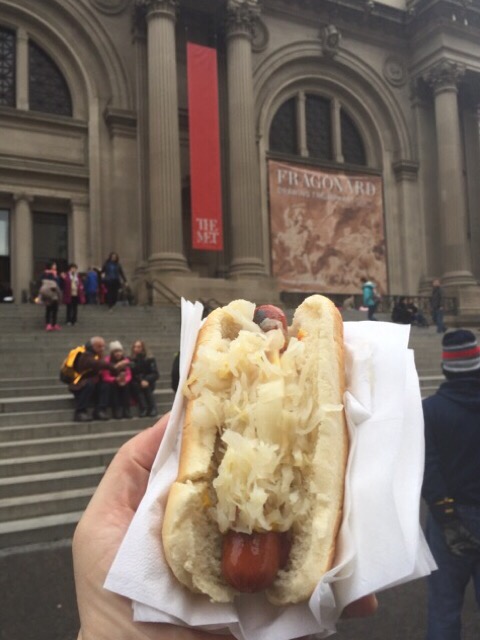
Inside, they are constantly rearranging, bring out new old things.
Here is something that I hadn’t recalled spending time with. I noticed a detail which I still need to verify, but seemed ominous and ghastly.
Herodias by Francesco Cairo (+1665).
This was cut down from a larger piece. There are similar works by Francesco Cairo in Boston and Vicenza showing the larger composition which includes the platter upon which rests the head of St. John the Baptist.
A detail…
It is hard to see, but it looks like she is holding between her pinchers a single hair. [It could be a pin.]
If that is so, then she is in ecstasy over her post-mortem torment of the Baptist.
Remember that John was killed partly because he said to the world something which could be a contemporary point of discussion: No, you may not have that woman as your wife. Herodias was outraged and she plotted her revenge.
Here is a lovely French ivory piece, as sweet as the other is awful. There is byzantine influence, of course. I find this very touching.
A marvelous bronze corpus, Italian.
The Met museum shop has a reproduction which I have been debating purchasing for several years. The reproduction is very good and it even as the wholes for nails. I thought I would have a wooden Cross made for it. As a member I get a good discount. ‘Tis also the season.
A while back I mentioned Michael O’Brian’s new book, The Fool of New York City
This painting figures in the book. Goya, of course. The cage is filled with finches… of the type which serves as the famous Christological Goldfinch.
This could be a good Christmas gift.
We had to go to the tree lighting. Only one time on Sunday afternoon. Detail.
I found the monkey again, and the pig is still crossing the bridge.
More on them later.
In the evening, CHINESE! There is no good Chinese where I live, alas.
Potatoes. Addictive.
Lamb with cumin.
Three pepper chicken. Whew.
So far so good. Today brings errands. I am meeting a friend for lunch and movie. I must stop at certain shops, including the place where I buy incense for the parish.
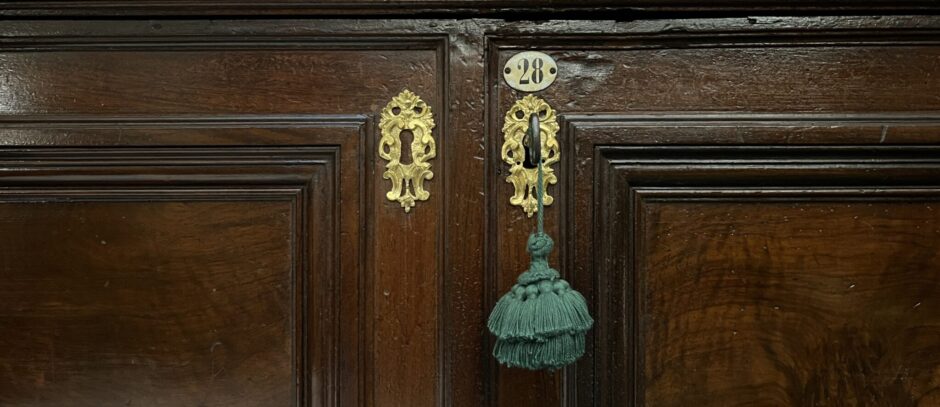


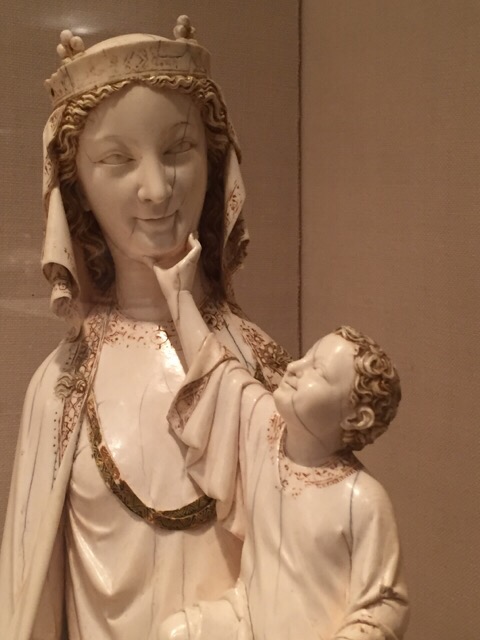
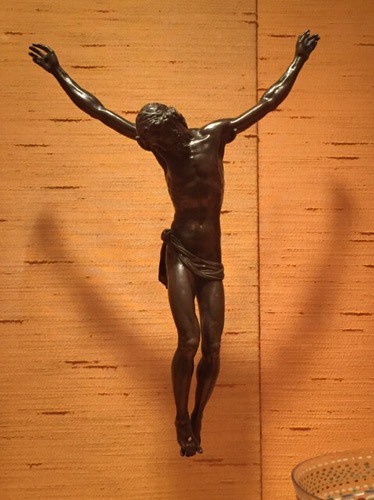
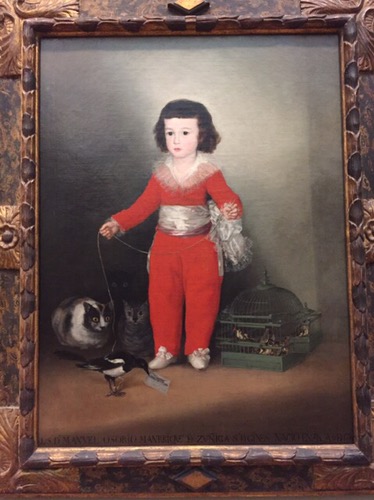
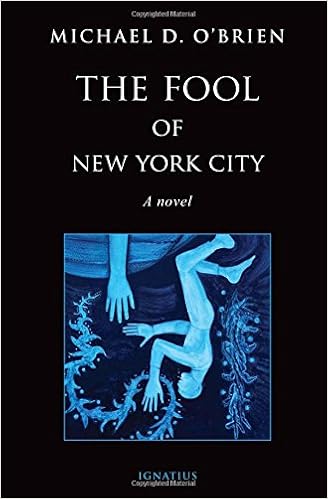
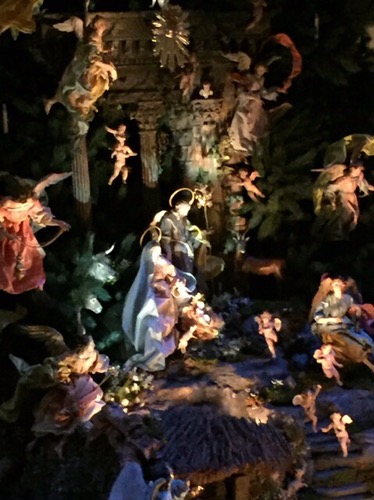


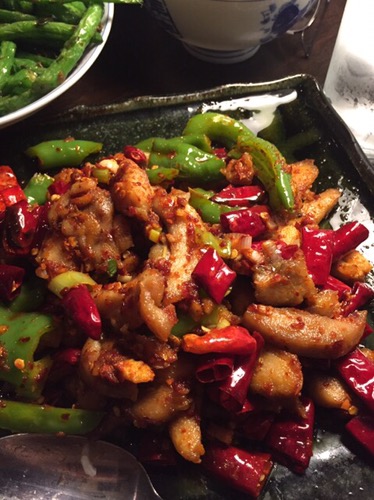

































In the painting of Herodias, I don’t think she is holding a hair of the Saint but a large pin. When I was little my mother told me that after Herodias received the head of Saint John the Baptist, she took a large pin and pierced his tongue in hateful spite.
A bit tangentially from the painting (and the recent baptismal name post), is ‘Battista’ a common epithet substituting for S. Giovanni? I was struck by the name of Archbishop Pierbattista: does that combine a St. Peter form with a St. John epithet (or am I simply ignorant of ‘ St. Peter the Baptist’)? The Archbishop’s surname strikes at least this Anglophone as curious, too: Pizzaballa – a common family name?
The New Criterion has posted several free articles about museums and their future, from the December issue:
http://www.newcriterion.com/
St John the Baptist, martyr for marriage, pray for us!
Will be in nYC in a couple of months. If you don’t mind advising me, which Chinese restaurant would you recommend?
The food in the photos is at Cafe China on East 37th St. in Manhattan.
I’ll be in NYC in January for the annual New York Encounter. (http://www.newyorkencounter.org/)
I’m definitely going to follow some of your food recommendations if you post the locations of your dinners. You always post amazing foodie photos.
The place with the amazing soup dumplings is Kung Fu Xiao Long Bao on Main St. in Flushing – take the #7 subway to the end, and walk south on Main St. about 1 mile.
Francesco Cairo. Seriously creepy Herodias. But then all his women look like that, so I don’t know what to think.
Thanks for always showing things from the Met! Many are saved to my New York-wishlist. Someday.
I was wondering if you could comment on “The Young Virgin” by Zubaran (Gallery 611)? It illustrates an aspect of Mary’s childhood that I was unaware of. How true it is, I do not know. However, after seeing this painting, I have seen a number of other pictures of Our Lady which contain a sewing basket/utensils . I’ve begun to spot them in the way that you spot goldfinches.
gracie: I was just looking at the painting on Sunday.
It looks like an early painting of Zurbaran, whom I very much like. I have a print of his Lemons, Oranges and Rose in my kitchen… lots of symbolism. In this one, however, you can see little still lives included, such as the book and cup and basket. The needle, poked into the embroidery – she is taking a pause to pray – is drawn with detail. The lily on the side, a still life, denotes purity. The drapes are exquisite, perhaps a medieval thrown back. And, it’s hard to see, she is wreathed overhead with myriads of angels, which is a commonplace in his paintings. The composition isn’t particularly interesting. There are caravaggesque lights and shadows. There was a tradition stemming from a pseudo-Scripture source, the Proto-Gospel of James that, at a very young age, Mary was taken to the Temple where she did precisely what girls and women were supposed to do: perfect the domestic arts, such as sewing. So, this painting also reflects a feminine ideal of the period. This is an image of what all young women should aspire to. The scattered flowers, part of the still life going on, made me wonder if she wasn’t pressing flowers in that book on the table. Also, the flowers could serve as patterns for her embroidery. What she is working on is similar to what she is wearing.
Speaking of Herodias, did you catch Salome at the MET Opera? The wigmaker/props people must go nuts each time another singer is cast as John the Baptist, since they have to make a head that looks like the singer for the final scene.
Thanks, Father. I’m going to take your commentary with me the next time I’m at the Met. If Mary was taken to the Temple at a young age and became skillful with the needle, perhaps she would have worked on sewing and repairing the tapestries/altar cloths/etc. that were there. This would provide one explanation as to why the Roman soldiers cast lots for Christ’s tunic, rather than cutting it into pieces. The inference is that the cloak was so exquisitely made – seamless, the commentary says, which seemed to make it a prize – that it was worth rolling the dice for it. If Mary had training in making vestments and made Jesus’ cloak, it would explain this unusual little side-note to the Crucifixion account. I don’t think I’m the first person to think it odd that Romans soldiers – who had access to the Roman-Graeco markets – would be vying for a homespun Galilean cloak.
One more thing – Although the composition may not be interesting, the subject matter is, at least for me, because I can’t think of one other painting that deals with this story.
gracie & Fr. Z,
My memory (an ’embroidery’ (!) of the Proto-Gospel of James? – I do not pause to research…) is that she was trained up to work on the Veil of the Temple – and that she indeed wove the “tunica inconsutilis, desuper contexta per totum” (St. John 19:23). I don’t think I ever connected the non-rending of this cloth and the rending of the Veil of the Temple till this moment, but expect exegetes will have discussed it in detail – also in connection with both as Our Lady’s handiwork. The iconography of the Annunciation often includes Our Lady at prayer with open book (and sometimes an additional closed book to hand) – and with things related to sewing and weaving: for example, Jan de Beer (c. 1520) has a magnificent piece of embroidery laid aside while she prays:
https://commons.wikimedia.org/wiki/File:Jan_de_Beer_-_Annunciation_-_WGA1562.jpg
I think I have read of a connection with Psalm 138: 15 in this context, the “fecisti in occulto; et substantia mea in inferioribus terrae” and the ‘making’ of Our Lord in Our Lady’s womb.